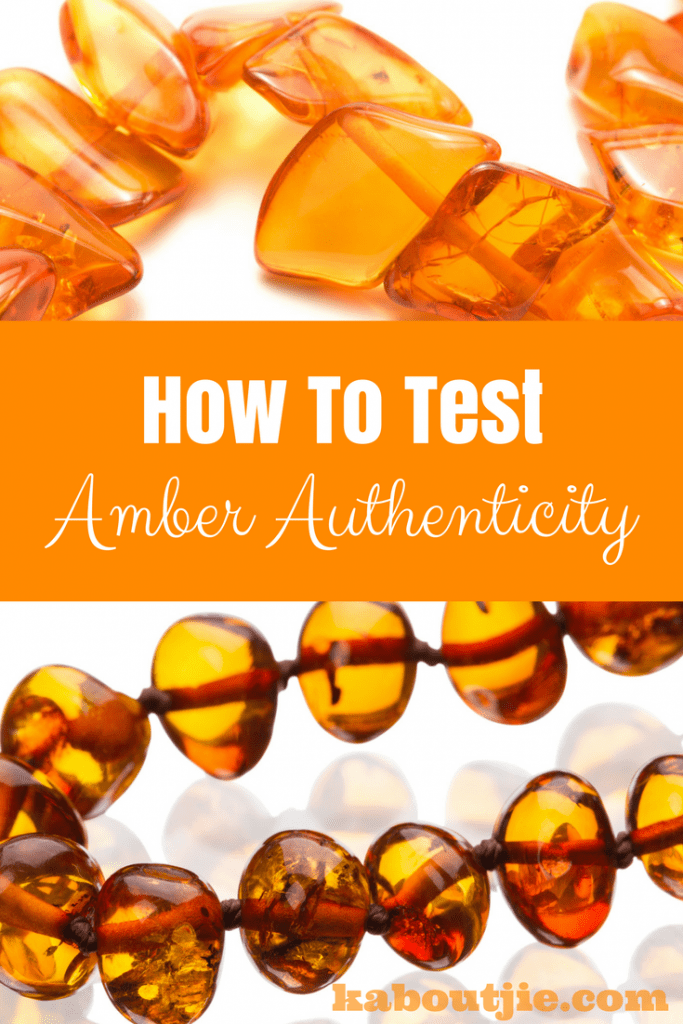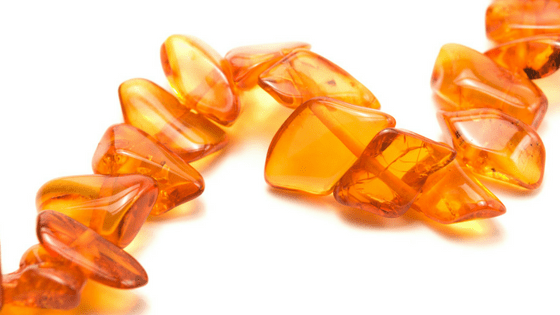Parents whose babies are teething are quite familiar with amber necklaces. However, people often end up buying fake ones because of how common they’ve become. Read on to find out how you can get to know if the necklace you’ve brought is the real deal!
Purchasing Authentic Amber Teething Necklaces
When an amber necklace comes in contact with the skin, the heat produced by the body releases a type of oil that contains succinic acid. When the skin absorbs this acid, it functions as a natural ibuprofen. It blocks the pain and reduces any inflammation.
For this reason, you wouldn’t want to purchase a teething necklace from a random place. The amber should come from the Baltic region since tests show that amber from the Baltic region has a higher amount of succinic acid than amber from other places.

Beware of Imposters
There are a few materials that are sold as authentic amber in the teething goods market when, in reality, they are far from the real thing. These common imposters include “copal”, which is basically adolescent amber that isn’t mature enough to be effective. However, it is commonly sold as amber.
Similarly, phenolic resins are used in the artificial amber beads while celluloid, glass, and casein (which happen to be plastic made from milk) are also sold as amber.
Also, beware of pressed amber, which are amber pieces fused together under very high pressure. In these instances, the succinic acid is also compressed, and the teething necklace is no longer effective.
Buying The Right Design
The necklace is going to be placed against your child’s skin beneath the clothes. For this reason, you need to make sure of the following:
- The beads shouldn’t have jagged edges that can harm the skin
- Every bead on the strand should be individually knotted
- All the beads should be tied and threaded with numerous strands for unbreakable strength
- All the materials used in the necklace should be completely natural
- The clasp should be either a screw clasp or a pop-clasp.

Look at It Closely
Real Baltic amber has certain characteristics, which show that it is completely authentic. When buying an amber necklace, make sure that you see or feel the following:
- The beads shouldn’t be round and each bead should vary in shape
- The beads aren’t perfect, which means that you should be able to see tiny imperfections within the beads like air bubbles
- The beads should be warm and not too smooth
- The beads should feel light in weight
Testing Your Amber Necklace
Amber has some unique features so to find out if the amber necklace you have is real or not, you can try out the best authenticity tests for Baltic amber.
Remember, if you purchase a fake amber necklace, then it won’t be able to deliver the health benefits you wanted to get such a necklace for.

- Salt Water Test
The Salt Water test is considered to be one of the most effective tests for identifying authentic amber from its imposters. For this test, you need around 7 tablespoons of salt along with one cup of water.
In the medium-sized cup, mix the water and salt until the salt is completely dissolved. Next, place the amber necklace in the water. If your amber is real, the necklace will easily float to the top of the cup while fake amber will sink.
This test isn’t recommended for jewelry that has metal in it; however, loose beads can be tested instantly.
- Rubbing Test
Since Copal is often sold as amber, you can do the rubbing test to differentiate between the two. Real amber possesses electrostatic properties; therefore, it can attract dust or tiny pieces of paper when charged sufficiently.
To charge the amber, wrap it up completely in a cloth. Rub the cloth for a minute, and then hold the beads near strands of your hair. With real amber, the hair will be attracted towards the stone, which means that static was produced. Meanwhile, if there is no attraction and the bead becomes sticky, the necklace you have is most likely made of copal.
- Hot Needle Test
Another test for differentiating authentic amber from fake amber is the hot needle test. For this, you have to heat a needle and then push the needle against the stone. If the needle goes in only slightly or if some cracks are left behind, the amber you have is authentic.
In the case of authentic amber, you will also be able to detect a distinct odor, which resembles the smell of a pine tree. On the other hand, with fake amber, the needle will go in completely, and the smell would be one resembling the odor of fresh paint or plastic.
However, only use this test if you are willing to leave behind a small mark on your amber necklace.
- Scratch Test
This test is usually done for identifying amber that doesn’t cost much because scratching the stone tends to damage it permanently. However, this test is helpful for separating amber from colored beads.
Since amber is quite soft, scratching it with metal will leave behind permanent scratches, while nothing will happen to glass beads. So, if you can easily scratch your jewelry beads then it is most likely authentic amber.
- Scent Test
People who are not too familiar with authentic amber might find this test slightly difficult; however, it is quite effective. For this test to be successful for you, you must know the difference between the smell of Baltic amber and copal.
The scent of real Baltic amber is quite stronger than the smell of copal. Meanwhile, if the necklace is made using some other imposter apart from copal then on heating the bead would smell like plastic.
Feel free to conduct these tests to determine the authenticity of your amber necklace. You need to have real amber if you wish to benefit from its natural healing properties.
About The Author
Jenn Sanders currently works as a marketing assistant at a company dedicated to the health and well-being of infants. Outside of work, she enjoys spending time with her family and outdoor adventures.
 Kaboutjie SA Mommy Blogs by Lynne Huysamen
Kaboutjie SA Mommy Blogs by Lynne Huysamen





Thanks for the tips . how ealy can i start using it on my baby.
I start at about 3 months because they tend to start drooling and biting on things at that age
My son in now 4 months and signs of teething are pretty obvious, my daughter only cut her 1st tooth at 11 months, not sure when this 1 will cut his 1st
I do really believe the amber necklaces have helped a great deal so I’m a firm believer
I also started at 3 months with my little boy. It works wonders. But I must say, I could see it was sore sometimes for him. But now he has a mouth full of teeth 🙂
This is so good to know… I hope we find the right one when it is time for us to start looking at this. I actually never knew that there is so many things to look for in this necklace.. Definitely have a good heads up now regarding that.
My little one also has one and I don’t know whether it is working. I’m also too scared to take it off. She do struggles a bit with teething.. I hope it’s helping her!
These necklaces work, believe me, you only realize how well they work when you lose them for a few days and your little one starts acting up. I have the African Amber which i bought from Takealot it is similar to the Baltic amber from Amazon and they both are authentic.
This must have been one of the best things be bought since becoming new parents.
If you managed to get your hands on the real deal, then you will reap the rewards.
JD’s teething was not a difficult process at all. Only once did he have very high fever when he developed two of his molars but overall it was a pretty painless experience.
I can honestly tell you that no amount of syrups, powders or ointments will give you the same effect. I was a bit sceptical at first when I learnt about a necklace that alleviates tooth and gum ache but once I read up on it and made sure I bought the real deal I was convinced otherwise.
Another tip: buy from a reputable supplier. These necklaces usually retail anything from R100 – R130. If you’re paying too little, then it’s probably not the real deal.
Since we bought our necklace, I’ve only used a bit of Calpol at times when JD was fussy and if I wanted to avoid fever. But overall, we’ve had no teething problems whatsoever.
I will recommend these baltic amber necklaces any day.
I have seen a lot of kids using these teething necklaces. (Not many boys, to be specific I have seen only one little boy using this)
I was also going to purchase one, however my husband was not in agreement as he said that the necklace looked to “girly” for a little boy to wear.
There were excellent reviews on a site that I had shown to him at the time, but this was of no use as his mind was already made up about the product.
Hopefully on baby number two, I will get a chance to try the necklace out.
I have 2 kids and never used this necklace.. My kids haven’t had any problem teething.. With my son I was too scared to try it out
You are so fortunate your kids never had any problems teething! My daughter struggled quite a bit until I got her the necklace.
I bought a plastic “amber necklace” before from someone and I was so upset – what a waste of money. I wish I had come across this post earlier.
All my grandchildren used the Amber Necklaces…i think its wonderful and it really helps
I’ve used the teething necklace with my first born and he had absolutely no symptoms of teething. Once I took the necklace off, he was extremely fussy and kept getting fevers when he was cutting teeth. I personally think that it’s so worth the money! The fake amber beads are much cheaper compared to the real thing too.
How fast do they start working though? Haven’t used one and I’m a 1st time mom?.
I found that it started working almost immediately. After a day I saw a reduction in teething symptoms but I’ve heard that some moms found it took longer.